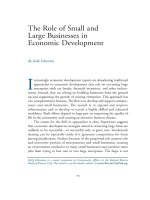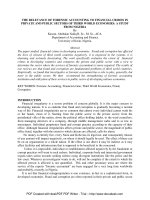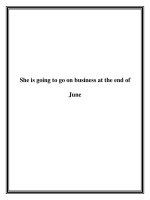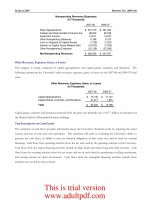heinberg - the end of growth; adapting to our new economic reality (2011)
Bạn đang xem bản rút gọn của tài liệu. Xem và tải ngay bản đầy đủ của tài liệu tại đây (3.05 MB, 344 trang )
Advance Praise for The End of Growth
Heinberg draws in the big three drivers of inevitable crisis—resource
constraints, environmental impacts, and financial system overload—
and explains why they are not individual challenges but one integrated
systemic problem. By time you finish this book, you will have come to
two conclusions. First, we are not facing a recession—this is the end
of economic growth. Second, this is not our children’s problem—it is
ours. It’s time to get ready, and reading this book is the place to start.
— PAUL GILDING, author, The Great Disruption,
Former head of Greenpeace International
Richard has rung the bell on the limits to growth. This is real. The
consequences for economics, finance, and our way of life in the
decades ahead will be greater than the consequences of the industrial
revolution were for our recent ancestors. Our coming shift from quantity
of consumption to quality of life is the great challenge of our generation
—frightening at times, but ultimately freeing.
— JOHN FULLERTON, President and Founder, Capital Institute
Why have mainstream economists ignored environmental limits for so
long? If Heinberg is right, they will have a lot of explaining to do. The
end of conventional economic growth would be a shattering turn of
events—but the book makes a persuasive case that this is indeed
what we are seeing.
— LESTER BROWN, Founder, Earth Policy Institute
and author, World on the Edge
Heinberg shows how peak oil, peak water, peak food, etc. lead not
only to the end of growth, and also to the beginning of a new era of
progress without growth.
— HERMAN E. DALY, Professor Emeritus,
School of Public Policy, University of Maryland
The End of Growth offers a comprehensive, timely and persuasive
analysis of the reality of ecological limits as they relate to economic
growth. Filled with facts and figures and very readable, the book
makes a rational case while paying attention to nuance and
counterarguments. A must-read for anyone who depends upon
economic growth, which means all of us.
— LESLIE E. CHRISTIAN, CFA, President and CEO Portfolio 21
Investments
Heinberg has masterfully summarized and updated the case against
economics, and its fraudulent scorecard—GDP. He explains why
conventional economic growth is ending now, and why growth of
human populations and material consumption will follow suit. Yet we all
can still grow in wisdom and continue expanding the knowledge of our
universe, while growing greener technologies capturing the sun’s daily
free photon flow as we transition to the Solar Age.
— HAZEL HENDERSON, author, The Politics of the Solar Age (1981)
and other books, President of Ethical Markets Media (USA and Brazil)
and its
Green Transition Scoreboard®
Dig into this book! It is crammed full of ideas, information and
perspective on where our troubled world is headed—a Baedeker for
the perplexed, and that’s most of us.
— JAMES GUSTAVE SPETH, author of The Bridge at the Edge of the
World:
Capitalism, the Environment and Crossing from Crisis to
Sustainability
Read this book and have the light switched on.
— CAROLINE LUCAS, Member of Parliament (UK)
Richard Heinberg is not one to shy away from difficult topics and The
End of Growth is no exception. Heinberg explains today’s
environmental and economic realities—which are scary to face. But
believe me, not facing them is a whole lot scarier. And as Heinberg
explains, the sooner we have this critically needed conversation about
how to live in a healthy, fair, and meaningful way on this one planet we
have, the better it will be for all of us.
—ANNIE LEONARD, author, The Story of Stuff
A vitally important book—it helps clear away many of the mistaken
assumptions that clutter our heads when we think about ‘obvious’ and
‘natural’ facts of our economic life. You really need to read it if you want
to understand the next few crucial years.
— BILL MCKIBBEN, author of Deep Economy and Eaarth
From all my research, I’m come to appreciate how much the
expectation of unending growth dominates public policy — and how
ephemeral that goal is likely to prove. Until now, however, no one has
had the foresight to address this critical topic. Congratulations to
Richard Heinberg for providing such a lucid account of the natural
limits to growth and the urgent need for a new economic model.
— MICHAEL KLARE, author, Rising Powers, Shrinking Planet
THE END
of
GROWTH
post carbon institute
The End of Growth is a “living book.”
Additional materials are being posted and updated
regularly at endofgrowth.com.
Also, you can join the conversation about EOG at
facebook.com/richardheinberg
facebook.com/postcarbon
THE END
of
GROWTH
Adapting to Our New Economic
Reality
RICHARD
HEINBERG
Copyright © 2011 by Richard Heinberg.
All rights reserved.
Cover design by Diane McIntosh.
Balloon: iStock © kutay tanir. Pin: iStock © Keith Webber Jr.
Background texture: iStock © toto8888 Printed in Canada.
First printing May 2011.
Paperback ISBN: 978-0-86571-695-7
eISBN: 978-1-55092-483-1
Inquiries regarding requests to reprint all or part of The End of Growth
should be addressed to New Society Publishers at the address below.
To order directly from the publishers, please call toll-free
(North America) 1-800-567-6772, or order online at www.newsociety.com
Any other inquiries can be directed by mail to:
New Society Publishers
P.O. Box 189, Gabriola Island, BC V0R 1X0, Canada
(250) 247-9737
New Society Publishers’ mission is to publish books that contribute in fundamental ways
to building an ecologically sustainable and just society, and to do so with the least
possible impact on the environment, in a manner that models this vision. We are
committed to doing this not just through education, but through action. Our printed, bound
books are printed on Forest Stewardship Council-certified acid-free paper that is 100%
post-consumer recycled (100% old growth forest-free), processed chlorine free, and
printed with vegetable-based, low-VOC inks, with covers produced using FSC-certified
stock. New Society also works to reduce its carbon footprint, and purchases carbon
offsets based on an annual audit to ensure a carbon neutral footprint. For further
information, or to browse our full list of books and purchase securely, visit our website at:
www.newsociety.com
Library and Archives Canada Cataloguing in Publication
Heinberg, Richard
The end of growth : adapting to our new economic reality / Richard Heinberg.
ISBN 978-0-86571-695-7
1. Economic indicators. 2. Economic forecasting.
3. Economic development. 4. Natural resources. I. Title.
HC59.3.H45 2011 330.9’05 C2011-902953-7
www.newsociety.com
DEDICATION
To P. J., whose generosity makes my work possible —
and who keeps going even with the knowledge
that time and means work against us.
Contents
Acknowledgments
Introduction: The New Normal
1. The Great Balloon Race
2. The Sound of Air Escaping
3. Earth’s Limits: Why Growth Won’t Return
4. Won’t Innovation, Substitution, and Efficiency Keep Us
Growing?
5. Shrinking Pie: Competition and Relative Growth in a Finite
World
6. Managing Contraction, Redefining Progress
7. Life After Growth
Notes
About the Author
Acknowledgments
This book has benefited from the contributions of many people whose
help deserves recognition.
I will start with the staff of Post Carbon Institute, the organization for
which I am happy and proud to work. Asher Miller, Daniel Lerch, Ken
White, and Tod Brilliant read the manuscript in various stages and
offered key editorial suggestions. This team has also collaborated with
me on related projects — including short YouTube videos such as the
award-winning“300 Years of Fossil Fuels in 300 Seconds” and “Who
Killed Growth?” Crystal Santorineos transcribed interviews and
Simone Osborne published excerpts from the book on
PostCarbon.org and EnergyBulletin.net (readers of those excerpts in
turn sent in valuable suggestions for the manuscript).
New Society Publishers also deserve thanks — especially Ingrid
Witvoet, who edited the manuscript; Chris and Judith Plant, who
responded enthusiastically to The End of Growth when it was no more
than an idea; Sue Custance who helped shepherd the project along;
and E. J. Hurst, who masterminded promotional efforts.
Jared Finnegan put his recent studies at the London School of
Economics to use in offering informed editorial suggestions for the
manuscript, and also in preparing the graphs and their captions — a
task that involved gathering dozens of data sets from a variety of
sources. Jared’s editorial input was especially crucial to the section
“The End of ‘Development’” in Chapter 5.
Suzanne Doyle contributed many hours to compiling the Notes,
finding sources and keeping track of hundreds of references.
My research for The End of Growth entailed interviews and
conversations with many brilliant thinkers, each of whom deserves an
introduction as well as my great thanks.
A conversation with Gus Speth — one of the giants of the
environmental movement, who taught for many years at Yale (and now
at Vermont Law School), and author of A Bridge at the Edge of the
World: Capitalism, the Environment, and Crossing from Crisis to
Sustainability — brought me up to speed with recent developments in
the world of alternative economics. Another conversation, this one with
John Fullerton, formerly Managing Director of JPMorgan and more
recently the founder of the Capital Institute, helped me understand the
culture of Wall Street and how it evolved during the past quarter
century. These days John is working on steering the investment world
toward a just, sustainable, and resilient economy and is pioneering
several promising efforts in that direction.
Herman Daly, pioneer ecological economist, former World Bank
economist, and author of The Growth Illusion, generously agreed to
read and comment on Chapter 6.
Nate Hagens, hedge fund manager-turned-ecological economist,
read most of the manuscript and contributed many important
suggestions; his expert knowledge of the workings of financial markets
informed Chapter 2.
Josh Farley, Fellow of the Gund Institute for Ecological Economics
and a Professor in the Community Development and Applied
Economics faculty at the University of Vermont (and co-author with
Herman Daly of the textbook Ecological Economics), read most of the
manuscript and provided crucial guidance in several areas. A few of
the explanatory Notes are lifted nearly verbatim from his comments in
the margins of the manuscript. Hazel Henderson, futurist and author of
Ethical Markets: Growing the Green Economy, has been critiquing
conventional economic theory for decades while offering alternative
ways of making money work for people (rather than the other way
around). Interviewing her helped open my thinking to possibilities I
hadn’t considered, and I tried to capture these in Chapters 6 and 7.
Chris Martenson, creator of “The Crash Course” and veteran of ten
years in corporate finance and strategic consulting, writes an ongoing
series of commentaries about the world financial situation. Because
Chris’s worldview is shaped by his awareness of resource limits and
by systems thinking, I find his analysis particularly credible and useful.
His insights are reflected in Chapter 2 and 3.
Nicole Foss is co-editor of TheAutomaticEarth.com, where she
writes under the name Stoneleigh; she also runs the Agri-Energy
Producers’ Association of Ontario, Canada, where she focuses on
farm-based bio-gas projects and grid connections for renewable
energy. While living in the UK, Nicole was a Research Fellow at the
Oxford Institute for Energy Studies, where she specialized in nuclear
safety in Eastern Europe and the former Soviet Union. I’ve benefited
from reading many of her commentaries on the world financial scene,
and Chapter 2 incorporates a number of important insights she
conveyed during a long conversation in December 2010.
Charles Hall, Professor of Systems Ecology at State University of
New York College of Environmental Science and Forestry in Syracuse,
is the world’s principal authority on the subject of net energy,
discussed in Chapter 4.While I owe a general, long-standing debt to
Charlie’s research (whose importance is still unrecognized by many
energy analysts), his most recent peer-reviewed publications provide
crucial support to some of the core arguments in this book.
David Murphy, one of Charlie Hall’s former students and now an
important researcher in his own right, is the author and co-author of
key peer-reviewed papers on net energy cited in Chapter 4. David
read that chapter and made important suggestions.
Michael Klare, Professor of Peace Studies at Hampshire College
and author of Rising Powers, Shrinking Planet, is the world’s foremost
authority on linkages between resource depletion and geopolitics. A
conversation with him in late 2010 was the basis for the section “Post-
Growth Geopolitics” in Chapter 5.
Bill Ryerson, founder and President of Population Media Center and
President of the Population Institute, is the wisest, best informed, and
most effective advocate for population issues I know. Our conversation
laid the groundwork for the section “Population Stress: Old vs. Young
on a Full Planet” in Chapter 5.
Mats Larsson, a management consultant and author of several
books including The Limits of Business Development and Economic
Growth, was an important source for Chapter 4, which he also read
and commented on.
Jason Bradford, a former research biologist at Washington
University and Missouri Botanical Garden, who currently leads the
farmland management program for Farmland LP, read and
commented upon much of the manuscript and drafted a sidebar for
Chapter 7.
Warren Karlenzig, one of the world’s top experts on urban
sustainability strategy and metrics, and author of How Green is Your
City? The SustainLane U.S. City Rankings, is a frequent traveler to
China, where he consults with local authorities on planning issues. His
insight into that nation’s predicament and prospects is reflected in the
section “The China Bubble” in Chapter 5.
David Fridley, staff scientist at the Energy Analysis Program at
Lawrence Berkeley National Laboratory and expert on China’s energy
policy, also offered important input to “The China Bubble.”
Doug Tompkins, who enjoyed notable success in business and went
on to become one of the world’s leading conservationists, read the
manuscript and made helpful suggestions, while the Foundation for
Deep Ecology provided material assistance for the promotion of this
book.
Helena Norberg-Hodge, founder of the International Society for
Ecology and Culture, has been a friend and inspiration for many years;
her perspective is explicit in the section “The End of ‘Development’” in
Chapter 5, but also subtly flavors Chapters 1 and 6.
These expert readers and sources kept me from making many
mistakes that would otherwise have compromised the core message
o f The End of Growth. Any errors that remain are my sole
responsibility.
I am also deeply indebted to the work of Dennis Meadows and
Jorgen Randers — the surviving members of the original Limits to
Growth research group. If the world had listened, today we would all
have much less to worry about.
Finally, I would like once again to thank my wife Janet Barocco for
her tireless support and encouragement, and for helping make our
home a place of artistry, good humor, and natural beauty.
Introduction: The New Normal
Leading active members of today’s economics
profession have formed themselves into a kind of
Politburo for correct economic thinking. As a general rule —
as one might generally expect from a gentleman’s club —
this has placed them on the wrong side of every important
policy issue, and not just recently but for decades. They
predict disaster where none occurs. They deny the
possibility of events that then happen They oppose the
most basic, decent and sensible reforms, while offering
placebos instead. They are always surprised when
something untoward (like a recession) actually occurs. And
when finally they sense that some position cannot be
sustained, they do not reexamine their ideas. They do not
consider the possibility of a flaw in logic or theory. Rather,
they simply change the subject.No one loses face, in this
club, for having been wrong. No one is dis-invited from
presenting papers at later annual meetings.And still less is
anyone from the outside invited in.
— James K. Galbraith (economist)
The central assertion of this book is both simple and startling:
Economic growth as we have known it is over and done with.
The “growth” we are talking about consists of the expansion of the
overall size of the economy (with more people being served and more
money changing hands) and of the quantities of energy and material
goods flowing through it.
The economic crisis that began in 2007–2008 was both
foreseeable and inevitable, and it marks a permanent, fundamental
break from past decades — a period during which most economists
adopted the unrealistic view that perpetual economic growth is
necessary and also possible to achieve. There are now fundamental
barriers to ongoing economic expansion, and the world is colliding
with those barriers.
This is not to say the US or the world as a whole will never see
another quarter or year of growth relative to the previous quarter or
year. However, when the bumps are averaged out, the general trend-
line of the economy (measured in terms of production and
consumption of real goods) will be level or downward rather than
upward from now on.
Nor will it be impossible for any region, nation, or business to
continue growing for a while. Some will. In the final analysis, however,
this growth will have been achieved at the expense of other regions,
nations, or businesses. From now on, only relative growth is possible:
the global economy is playing a zero-sum game, with an ever-shrinking
pot to be divided among the winners.
Why Is Growth Ending?
Many financial pundits have cited serious troubles in the US economy
— including overwhelming, un-repayable levels of public and private
debt, and the bursting of the real estate bubble — as immediate
threats to economic growth. The assumption generally is that
eventually, once these problems are dealt with, growth can and will
resume at “normal” rates. But the pundits generally miss factors
external to the financial system that make a resumption of
conventional economic growth a near-impossibility. This is not a
temporary condition; it is essentially permanent.
Altogether, as we will see in the following chapters, there are three
primary factors that stand firmly in the way of further economic growth:
• The depletion of important resources including fossil fuels and
minerals;
• The proliferation of negative environmental impacts arising from
both the extraction and use of resources (including the burning of
fossil fuels) — leading to snowballing costs from both these
impacts themselves and from efforts to avert them; and
• Financial disruptions due to the inability of our existing monetary,
banking, and investment systems to adjust to both resource
scarcity and soaring environmental costs — and their inability (in
the context of a shrinking economy) to service the enormous piles
of government and private debt that have been generated over the
past couple of decades.
Despite the tendency of financial commentators to ignore
environmental limits to growth, it is possible to point to literally
thousands of events in recent years that illustrate how all three of the
above factors are interacting, and are hitting home with ever more
force.
Consider just one: the Deepwater Horizon oil catastrophe of 2010 in
the US Gulf of Mexico.
The fact that BP was drilling for oil in deep water in the Gulf of
Mexico illustrates a global trend: while the world is not in danger of
running out of oil anytime soon, there is very little new oil to be found in
onshore areas where drilling is cheap. Those areas have already been
explored and their rich pools of hydrocarbons are being depleted.
According to the International Energy Agency, by 2020 almost 40
percent of world oil production will come from offshore. So even though
it’s hard, dangerous, and expensive to operate a drilling rig in a mile or
two of ocean water, that’s what the oil industry must do if it is to
continue supplying its product. That means more expensive oil.
Obviously, the environmental costs of the Deepwater Horizon
blowout and spill were ruinous. Neither the US nor the oil industry can
afford another accident of that magnitude. So, in 2010 the Obama
administration instituted a deepwater drilling moratorium in the Gulf of
Mexico while preparing new drilling regulations. Other nations began
revising their own deepwater oil exploration guidelines. These will no
doubt make future blowout disasters less likely, but they add to the
cost of doing business and therefore to the already high cost of oil.
The Deepwater Horizon incident also illustrates to some degree the
knock-on effects of depletion and environmental damage upon
financial institutions. Insurance companies have been forced to raise
premiums on deepwater drilling operations, and impacts to regional
fisheries have hit the Gulf Coast economy hard. While economic costs
to the Gulf region were partly made up for by payments from BP, those
payments forced the company to reorganize and resulted in lower
stock values and returns to investors. BP’s financial woes in turn
impacted British pension funds that were invested in the company.
This is just one event — admittedly a spectacular one. If it were an
isolated problem, the economy could recover and move on. But we
are, and will be, seeing a cavalcade of environmental and economic
disasters, not obviously related to one another, that will stymie
economic growth in more and more ways. These will include but are
not limited to:
• Climate change leading to regional droughts, floods, and even
famines;
• Shortages of energy, water, and minerals; and
• Waves of bank failures, company bankruptcies, and house
foreclosures.
Each will be typically treated as a special case, a problem to be
solved so that we can get “back to normal.” But in the final analysis,
they are all related, in that they are consequences of a growing human
population striving for higher per-capita consumption of limited
resources (including non-renewable, climate-altering fossil fuels), all on
a finite and fragile planet.
Meanwhile, the unwinding of decades of buildup in debt has created
the conditions for a once-in-a-century financial crash — which is
unfolding around us, and which on its own has the potential to generate
substantial political unrest and human misery.
The result: we are seeing a perfect storm of converging crises that
together represent a watershed moment in the history of our species.
We are witnesses to, and participants in, the transition from decades
of economic growth to decades of economic contraction.
The End of Growth Should Come As No
Surprise
The idea that growth will stall out at some point this century is hardly
new. In 1972, a book titled Limits to Growth made headlines and went
on to become the best-selling environmental book of all time.
1
That book, which reported on the first attempts to use computers to
model the likely interactions between trends in resources,
consumption, and population, was also the first major scientific study
to question the assumption that economic growth can and will continue
more or less uninterrupted into the foreseeable future.
State of the World
FIGURE 1. Limits to Growth Scenario. Source: The Limits
to Growth: The 30-Year Update (2004), p. 169.
The idea was heretical at the time — and still is. The notion that
growth cannot and will not continue beyond a certain point proved
profoundly upsetting in some quarters, and soon Limits to Growth was
prominently “debunked” by pro-growth business interests. In reality, this
“debunking” merely amounted to taking a few numbers in the book
completely out of context, citing them as “predictions” (which they
explicitly were not), and then claiming that these predictions had
failed.
2
The ruse was quickly exposed, but rebuttals often don’t gain
nearly as much publicity as accusations, and so today millions of
people mistakenly believe that the book was long ago discredited. In
fact, the original Limits to Growth scenarios have held up quite well. (A
recent study by Australian Commonwealth Scientific and Industrial
Research Organization (CSIRO) concluded, “[Our] analysis shows that
30 years of historical data compares favorably with key features of [the
Limits to Growth] business-as-usual scenario ”)
3
The authors fed in data for world population growth, consumption
trends, and the abundance of various important resources, ran their
computer program, and concluded that the end of growth would
probably arrive between 2010 and 2050. Industrial output and food
production would then fall, leading to a decline in population.
The Limits to Growth scenario study has been re-run repeatedly in
the years since the original publication, using more sophisticated
software and updated input data. The results have been similar each
time.
4
Why Is Growth So Important?
During the last couple of centuries, economic growth became virtually
the sole index of national well-being. When an economy grew, jobs
appeared and investments yielded high returns. When the economy
stopped growing temporarily, as it did during the Great Depression,
financial bloodletting ensued.
Throughout this period, world population increased — from fewer
than two billion humans on planet Earth in 1900 to over seven billion
today; we are adding about 70 million new “consumers” each year.
That makes further economic growth even more crucial: if the economy
stagnates, there will be fewer goods and services per capita to go
around.
We have relied on economic growth for the “development” of the
world’s poorest economies; without growth, we must seriously
entertain the possibility that hundreds of millions — perhaps billions —
of people will never achieve the consumer lifestyle enjoyed by people
in the world’s industrialized nations. From now on, efforts to improve
quality of life in these nations will have to focus much more on factors
such as cultural expression, political freedoms, and civil rights, and
much less on an increase in GDP.
Moreover, we have created monetary and financial systems that
require growth. As long as the economy is growing, that means more
money and credit are available, expectations are high, people buy
more goods, businesses take out more loans, and interest on existing
loans can be repaid.
5
But if the economy is not growing, new money
isn’t entering the system, and the interest on existing loans cannot be
paid; as a result, defaults snowball, jobs are lost, incomes fall, and
consumer spending contracts — which leads businesses to take out
fewer loans, causing still less new money to enter the economy. This is
a self-reinforcing destructive feedback loop that is very difficult to stop
once it gets going.
In other words, the existing market economy has no “stable” or
“neutral” setting: there is only growth or contraction. And “contraction”
can be just a nicer name for recession or depression — a long period
of cascading job losses, foreclosures, defaults, and bankruptcies.
We have become so accustomed to growth that it’s hard to
remember that it is actually is a fairly recent phenomenon.
Over the past few millennia, as empires rose and fell, local
economies advanced and retreated — while world economic activity
overall expanded only slowly, and with periodic reversals. However,
with the fossil fuel revolution of the past century and a half, we have
seen economic growth at a speed and scale unprecedented in all of
human history.
6
We harnessed the energies of coal, oil, and natural
gas to build and operate cars, trucks, highways, airports, airplanes,
and electric grids — all the essential features of modern industrial
society. Through the one-time-only process of extracting and burning
hundreds of millions of years’ worth of chemically stored sunlight, we
built what appeared (for a brief, shining moment) to be a perpetual-
growth machine. We learned to take what was in fact an extraordinary
situation for granted. It became normal.
But as the era of cheap, abundant fossil fuels comes to an end, our
assumptions about continued expansion are being shaken to their
core. The end of growth is a very big deal indeed. It means the end of
an era, and of our current ways of organizing economies, politics, and
daily life.
It is essential that we recognize and understand the significance of
this historic moment: if we have in fact reached the end of the era of
fossil.fueled economic expansion, then efforts by policy makers to
continue pursuing elusive growth really amount to a flight from reality.
World leaders, if they are deluded about our actual situation, are likely
to delay putting in place the support services that can make life in a
non-growing economy tolerable, and they will almost certainly fail to
make needed, fundamental changes to monetary, financial, food, and
transport systems.
As a result, what could be a painful but endurable process of
adaptation could instead become history’s greatest tragedy. We can
survive the end of growth, and perhaps thrive beyond it, but only if we
recognize it for what it is and act accordingly.
BOX I.1 But Isn’t the US Economy Recovering?
From July 2009 through the end of 2010, the US economy posted
GDP gains — i.e., signs of growth. Nominal GDP surpassed pre-
recession levels in mid-2010, while inflation-adjusted GDP nearly
returned to its pre-recession level.
7
This followed GDP contraction in
the months December 2007 through June 2009.
8
But, as we will see in Chapter 6, GDP is a poor gauge of overall
economic health. Even if GDP has returned to former levels, the
economy of the United States is fundamentally changed:
unemployment levels are much higher and tax revenues for state and
local governments are severely reduced. Some economists may
define this technically as a recovering and growing economy, but it
certainly is not a healthy one.
Moreover, much of this apparent growth has come about because
of enormous injections of stimulus and bailout money from the Federal
government. Subtract those, and the GDP growth of the past year or
so almost disappears.
On the basis of historical analysis of previous financial crises,
economists Carmen Reinhart and Kenneth Rogoff conclude that the
economic crisis of 2008 will have
“. . .deep and lasting effects on asset prices, output and
employment. Unemployment rises and housing price declines extend
out for five and six years, respectively. On the encouraging side, output
declines last only two years on average. Even recessions sparked by
financial crises do eventually end, albeit almost invariably
accompanied by massive increases in government debt The global
nature of the [current] crisis will make it far more difficult for many
countries to grow their way out through higher exports, or to smooth
the consumption effects through foreign borrowing. In such
circumstances, the recent lull in sovereign defaults is likely to come to
an end.”
9
But this analysis considers only the financial aspects of the crisis
and ignores the deeper issues of energy, resources, and environment.
The “recovery” that began in 2009 occurred in the context of energy
prices that had fallen substantially from their peak in mid-2008; but as
consumer demand showed tepid signs of revival in late 2010, oil
prices lofted upward again. If this “recovery” continues, energy prices
will rise even further and contraction will resume.
In short: while the US economy may have posted growth (as
technically defined) in 2009–2010, it is operating in a fundamentally
different mode than before: it is led to a greater extent than before by
government spending (as opposed to consumer activity), and it is
hostage to energy prices.
FIGURE 2. Economic Growth and Unemployment,
2006–2010. As the US economy contracted from the
financial crisis in 2008, economic growth went negative and
the unemployment rate shot up. Source: US Bureau of Labor
Statistics, US Bureau of Economic Analysis.
FIGURE 3. Economic Growth, Stimulus, and Bailouts.
“Bailout and Stimulus” refers to the Troubled Asset Relief
Program (TARP) and the American Recovery and
Reinvestment Act of 2009. As this graph shows, these









